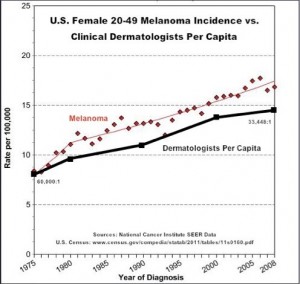By Marc Sorenson, EdD. Sunlight Institute…
Are phototherapy sessions in a dermatologist’s office safe?
As we have indicated, dermatologists and their organizations, with certain refreshing exceptions, promote the idea that both tanning beds and natural sun exposure are detrimental to health. Yet, thousands of dermatologists use UVR light to reduce the risk of many skin diseases. They claim that their UVR exposure is totally safe. That is an egregious example of duplicity at its worst. Recently, Dr. Anne Haas, President of the California Dermatology Society, made an egregiously false statement at a regulatory hearing regarding UVR devices, saying that whereas tanning beds were cancer causers, the UVR devices used in dermatologists’ offices had never been shown to cause any cancer problems. Watch this short video to hear her statement:
Her statement, that there is no evidence UV devices in the dermatologist’s office cause cancer, is ludicrous. Here is the truth:
- The light used by dermatologists is the same type of light used in tanning beds.[1] [2]
- The use of phototherapy in the dermatologist offices definitely do lead to an increase in skin cancer.[3] And some of that skin cancer was sufficiently noteworthy that the researchers concluded their study with this warning: “A noteworthy number of NMSC were diagnosed in this Mediterranean population of patients exposed to high-dose UV treatment. A thorough risk-benefit evaluation should always be done before UV treatment and patients should be carefully monitored for skin cancer during and after treatment discontinuation.”[4]
- The National Psoriasis Foundation recommends brief, frequent exposures of sunlight as a therapy and report that 80% of those who do it improve or totally clear psoriasis.[5]
- Many honest dermatologists recommend tanning-bed use to their patients to clear psoriasis. Obviously it is effective for that disease, and if phototherapy in the dermatologist’s office causes skin cancer, what seems to be the problem? Both therapies work. Why deny someone with psoriasis the benefits of a lower cost and possibly easier accessibility to treatment?[6]
So why the deception? The answer lies in money. When scientists such as those in the last quoted paper advocate tanning beds for therapy, it could cost the dermatology industry a fortune.
Your will note in the graph below that melanoma incidence has increased nearly in lockstep with the increase in the number of dermatologists. What a business! Is there any doubt why they don’t want the tanning industry absorbing the money made from their lucrative and expensive office treatments? Think about it.
Now you know a few more facts about sunlight, tanning beds, health and the deception of the anti-sun groups. Let it sink in and then make your own decision abut sun or tanning bed exposure. And while you decide, please consider the calculation I’ve made in my new book to be released soon: For every death caused by diseases that associate with sun exposure, there are about 350 deaths associated with sun deprivation. Which way would you like to bet?
[1] Archier E1, Devaux S, Castela E, Gallini A, Aubin F, Le Maître M, Aractingi S, Bachelez H, Cribier B, Joly P, Jullien D, Misery L, Paul C, Ortonne JP, Richard MA. Carcinogenic risks of psoralen UV-A therapy and narrowband UV-B therapy in chronic plaque psoriasis: a systematic literature review. J Eur Acad Dermatol Venereol. 2012 May;26 Suppl 3:22-31.
[2] Radack KP, Farhangian ME, Anderson KL, Feldman SR. A review of the use of tanning beds as a dermatological treatment. Dermatol Ther (Heidelb). 2015 Mar;5(1):37-51.
[3] Egeberg A, Thyssen JP, Gislason GH, Skov L. Skin cancer in patients with psoriasis. J Eur Acad Dermatol Venereol. 2016 Mar 2. doi: 10.1111/jdv.13619. [Epub ahead of print].
[4] Maiorino A, De Simone C, Perino F, Caldarola G, Peris K. Melanoma and non-melanoma skin cancer in psoriatic patients treated with high-dose phototherapy. J Dermatolog Treat. 2016 Jan 28:1-5. [Epub ahead of print].
[5] National Psoriasis Foundation web site Oct. 2005.
[6] Radack KP, Farhangian ME, Anderson KL, Feldman SR. A review of the use of tanning beds as a dermatological treatment. Dermatol Ther (Heidelb). 2015 Mar;5(1):37-51.

